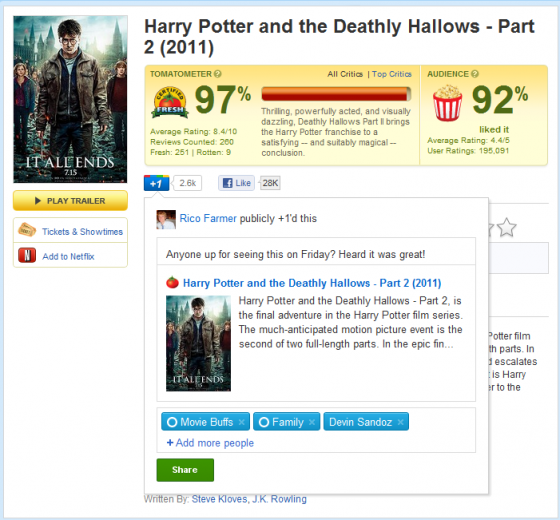 Google is in the process of rolling out new improvements to the Goolge +1 button to enable Facebook-like sharing as an option when Google+ users click the Google +1 button. This behavior will be available by default to users logged into Google with a Google+ account.
Google is in the process of rolling out new improvements to the Goolge +1 button to enable Facebook-like sharing as an option when Google+ users click the Google +1 button. This behavior will be available by default to users logged into Google with a Google+ account.
Now in addition to +1ing the page, users will get a pop up window similar to Facebook where they can choose to share the +1’d content on Google+. As with all Google+ sharing, by default users will have the ability to choose which circles can see the shared content, or to make it public, or not to share it at all.
This new +1 button behavior is not available to everyone just yet (I do not have it yet for my Google+ account) but it should be available everywhere within a couple of days.
Publishers Can Customize What is Shared
In a very nice step up from Facebook sharing, Google +1 button sharing also provides publishers a way to customize exactly what content gets pulled into the share window. By default Google+ will pull in a title, a small chunk of text, and an image from the page — just like Facebook does.
But if you’ve ever paid attention to how your content is shared on Facebook you’ll no doubt have noticed that Facebook sometimes does pretty horrible job of picking what content is shared:
Facebook sometimes chooses page template navigational icons as the highlighted image rather than the image in the content, and repeating the top navigation menu as the description text. Google+ gives you some control over what appears by paying attention to the rich annotations using the already existing schema.org standards. If you’re already using these, you’ll be set. If not, here is the annotation example that Goolge gives on their Webmaster Central Blog:
<body itemscope itemtype="//schema.org/Article">
<h1 itemprop="name">This is the article name</h1>
<img itemprop="image" src="thumbnail.jpg" />
<p itemprop="description">This is the description of the article.</p>
</body>
To incorporate the rich annotations you’ll need to update the template of your site; however, you can argue that this is something that you can benefit from doing anyway, as it gives Google’s search engine a better understanding of your site and the ability to present more information about your site.







